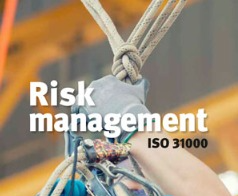ISO 31000:2018 – Risk Management System: Empowering Organizations to Manage Uncertainty
In today’s rapidly evolving business landscape, organizations of every size and sector face unprecedented challenges and uncertainties. From economic instability and cyber threats to supply chain disruptions and natural disasters, risks are an inevitable part of every organization’s journey. To effectively anticipate and manage these uncertainties, businesses need a structured and reliable framework. This is where ISO 31000:2018, the international standard for Risk Management, becomes invaluable.
ISO 31000:2018 provides clear guidelines and principles that help organizations establish a proactive risk management culture—one that focuses on resilience, informed decision-making, and continuous improvement.
What is ISO 31000:2018?
ISO 31000:2018 is an international standard published by the International Organization for Standardization (ISO) that outlines principles, frameworks, and processes for effective risk management.
Unlike many ISO standards, ISO 31000 is not intended for certification, but rather as a guideline that can be applied to any organization—large or small, public or private, in any industry. Its purpose is to help organizations integrate risk management into their governance, leadership, and operational processes.
The standard provides a common approach to managing all types of risks, whether they relate to strategic objectives, operations, projects, finances, environment, or reputation.
Simply put, ISO 31000 helps organizations anticipate the unexpected—turning potential threats into opportunities for growth and improvement.
Objectives of ISO 31000:2018
The primary goal of ISO 31000 is to ensure that organizations can identify, evaluate, and manage risks systematically. Its key objectives include:
-
Enhancing decision-making by incorporating risk-based thinking.
-
Protecting and creating value by minimizing losses and maximizing opportunities.
-
Improving organizational performance through proactive risk management.
-
Strengthening resilience against internal and external threats.
-
Integrating risk management into all areas of operations and leadership.
By following ISO 31000, organizations can make better strategic and operational decisions, ensuring long-term stability and sustainability.
Key Principles of ISO 31000:2018
ISO 31000 is built on a set of core principles that ensure effective and efficient risk management. These principles emphasize that managing risk should be integrated, structured, and dynamic.
Here are the main principles:
-
Integration: Risk management should be an integral part of all organizational activities, from strategic planning to daily operations.
-
Structured and Comprehensive: A consistent and logical approach ensures reliable and comparable results.
-
Customized: The framework should be tailored to the organization’s context, culture, and objectives.
-
Inclusive: Involving stakeholders at every level enhances transparency and accountability.
-
Dynamic: Risks evolve over time; therefore, organizations must continuously monitor and adapt to changes.
-
Best Available Information: Decisions should be based on accurate, up-to-date, and relevant data.
-
Human and Cultural Factors: Recognizing human behavior and organizational culture plays a critical role in managing risk.
-
Continuous Improvement: Risk management processes should be regularly evaluated and improved.
These principles ensure that risk management becomes a strategic enabler rather than a reactive process.
Framework of ISO 31000:2018
The ISO 31000 framework provides a structured foundation for implementing effective risk management. It includes five key components:
-
Leadership and Commitment:
Top management must demonstrate strong leadership and allocate the necessary resources to ensure the success of the risk management framework.
-
Integration:
Risk management should be embedded into all organizational functions, including decision-making, project planning, and operational management.
-
Design:
The framework should be designed according to the organization’s internal and external context, ensuring that it aligns with the company’s goals, culture, and values.
-
Implementation:
The organization should apply risk management principles and processes to all operations, projects, and business decisions.
-
Evaluation and Improvement:
Continuous monitoring, measurement, and improvement help refine the framework and ensure its effectiveness over time.
This structure promotes a proactive and systematic approach to identifying, analyzing, and responding to risks.
The Risk Management Process
ISO 31000 outlines a simple yet effective process for managing risk. The steps include:
-
Communication and Consultation:
Engage with internal and external stakeholders to ensure mutual understanding and collaboration in the risk management process.
-
Establishing the Context:
Define the scope, objectives, and criteria for risk management based on the organization’s environment and strategic goals.
-
Risk Assessment:
-
Risk Identification: Determine potential risks that could affect objectives.
-
Risk Analysis: Evaluate the likelihood and impact of these risks.
-
Risk Evaluation: Prioritize risks based on their significance and decide how to handle them.
-
Risk Treatment:
Develop strategies to mitigate, transfer, accept, or avoid risks based on their impact and probability.
-
Monitoring and Review:
Continuously track risks, evaluate control effectiveness, and identify new or emerging risks.
This process is cyclical, ensuring that organizations can adapt to new challenges and continuously improve their risk management capabilities.
Benefits of Implementing ISO 31000:2018
Implementing ISO 31000 brings numerous advantages to organizations across all sectors:
1. Enhanced Decision-Making
With structured risk management, organizations can make more informed decisions by understanding potential threats and opportunities.
2. Greater Resilience
ISO 31000 helps organizations prepare for and recover from unexpected events, ensuring operational continuity.
3. Increased Stakeholder Confidence
Investors, regulators, and customers gain confidence in organizations that demonstrate robust risk management practices.
4. Improved Governance and Compliance
The standard promotes accountability, transparency, and compliance with regulatory requirements.
5. Cost Efficiency
By identifying and mitigating risks early, organizations reduce losses, avoid costly disruptions, and allocate resources effectively.
6. Competitive Advantage
A well-managed risk environment enhances reputation and gives businesses an edge over competitors in high-risk industries.
7. Continuous Improvement
The cyclical nature of ISO 31000 encourages learning, innovation, and improvement across all levels of the organization.
Who Can Implement ISO 31000:2018?
One of the major strengths of ISO 31000 is its universality. It applies to all types of organizations, including:
-
Corporations and SMEs
-
Public sector bodies
-
Educational and healthcare institutions
-
Financial and insurance organizations
-
Non-profit and community organizations
Whether an organization operates in manufacturing, services, or government, ISO 31000 helps manage risks systematically and effectively.
ISO 31000:2018 and Other ISO Standards
ISO 31000 aligns seamlessly with other management system standards, such as:
-
ISO 9001 (Quality Management)
-
ISO 14001 (Environmental Management)
-
ISO 45001 (Occupational Health & Safety)
-
ISO 22301 (Business Continuity Management)
This integration enables organizations to adopt a holistic approach to managing quality, safety, environment, and risk under a unified management system.
Conclusion
In an era marked by uncertainty and complexity, ISO 31000:2018 serves as a strategic tool that empowers organizations to face risks with confidence. It transforms risk management from a defensive activity into a value-creating process—helping businesses anticipate challenges, capitalize on opportunities, and achieve their objectives efficiently.
By adopting ISO 31000 principles, organizations build resilience, accountability, and adaptability, ensuring they are prepared not just to survive challenges but to thrive in the face of them.
Ultimately, effective risk management is not about eliminating risks—it’s about mastering them.






